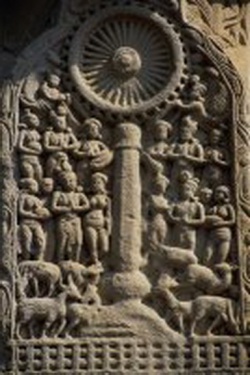Wheel
- See also :
- See also :
The wheel (cakka) is a flat circular object that turns as it moves. The ancient Indians used the wheel as a symbol for political sovereignty and domain. The first Buddhists used it as a symbol for sovereignty too, only for spiritual rather than for political sovereignty. The Buddha’s first discourse is called ‘Setting in Motion the Wheel of the Dhamma.’ (S.V,420). The rim of the wheel (mukhavaṭṭi) represent movement or progress and the spokes (ara) and hub (nābhi) represent the coming together of multiple things into a unity. Generosity, kindly speech, doing good for others and treating them with impartiality are to the world, the Buddha said, what the linchpin (āṇi) is to the wheel (A.II,32), i.e. they keep it turning smoothly. A wheel flanked on either side by a deer has long been used to symbolize the Buddha’s teaching of this discourse at the Deer Park at Sārnāth.
Today the wheel as a symbol for Buddhism is often depicted with eight spokes representing the Noble Eightfold Path although this is a relatively recent innovation. In the scriptures the Dhamma wheel, called either the Supreme Wheel (brahmacakka) or Highest Wheel (anuttaraṃ dhammacakkaṃ, A.III,9; 148), was perceived as being ‘a thousand-spoked’ (sahassāraṃ, D.III,60). Before the advent of statues, the Buddha was often represented by a wheel. What the cross is to Christians, the ying yang symbol to Taoists and the Om sign to Hindus, the wheel is to Buddhists.
The Buddhist Wheel Symbol, T. Karunaratne, 1969.
